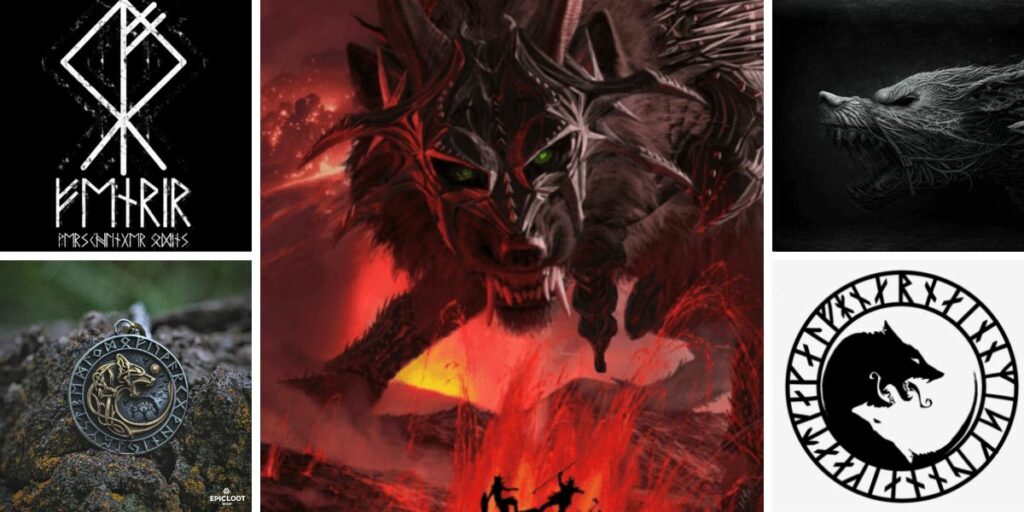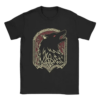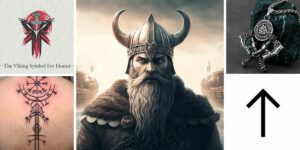The Norse rune for Fenrir is a captivating subject, blending the raw power of Norse mythology with the intricate art of runic symbolism. Fenrir, the monstrous wolf destined to shape the fate of the gods, holds a significant place in Viking lore. This article explores Fenrir’s mythological roots, the runes associated with him, and how to represent his name in Elder Futhark runes. We’ll also delve into bindrunes, tattoo designs, and Fenrir’s lasting impact on modern culture.
Fenrir: The Monstrous Wolf of Norse Mythology
Origins and Fate
Fenrir, whose name means “fen-dweller” in Old Norse, is a colossal wolf born to the trickster god Loki and the giantess Angrboða. Alongside his siblings, Hel (goddess of the underworld) and Jörmungandr (the world serpent), Fenrir was destined to play a pivotal role in Ragnarök, the Norse apocalypse. According to prophecy, Fenrir will slay Odin, the Allfather, during this cataclysmic event, embodying the inevitable destruction that precedes renewal.
>>> Nordic Rune for Wolf: Symbols, Meanings & Viking Connections
The Binding Myth
The gods, wary of Fenrir’s growing strength, sought to bind him. After two failed attempts with iron chains, they commissioned the dwarves to create Gleipnir, a magical ribbon woven from impossible elements like the sound of a cat’s footsteps and the roots of a mountain. To secure Fenrir’s trust, the god Tyr placed his hand in the wolf’s mouth as a pledge. When Fenrir realised he was trapped, he bit off Tyr’s hand, cementing his reputation as a force of untamed power.
Symbolism
Fenrir is not merely a villain in Norse mythology. He represents chaos, destiny, and the cyclical nature of destruction and rebirth. His story reflects the Viking understanding of nature’s duality—neither wholly good nor evil, but a necessary force in the cosmic balance.
The Norse Rune for Fenrir: Myth vs. Reality

No Direct Rune
Contrary to popular belief, there is no single Elder Futhark rune that exclusively represents Fenrir. The Elder Futhark, the oldest runic alphabet used by the Vikings, consists of 24 runes, each with its own phonetic and symbolic meaning. Instead of a dedicated Fenrir rune, his essence is captured through combinations of runes or artistic depictions.
>>> Viking Rune for Bear: Symbolism, Meaning & Tattoo Ideas
Bindrunes
A fenrir bind rune combines multiple runes into a single, cohesive symbol. Common choices include:
-
Tiwaz (ᛏ): Associated with Tyr and sacrifice, reflecting the god’s lost hand.
-
Uruz (ᚢ): Symbolising primal strength and wildness, aligning with Fenrir’s untamed nature.
These runes are interwoven to create a fenrir rune symbol that encapsulates the wolf’s mythological significance.
Symbolic Associations
Certain runes resonate with Fenrir’s story:
-
Thurisaz (ᚦ): Represents giants and chaos, tying to Fenrir’s giant ancestry.
-
Eihwaz (ᛇ): Linked to Yggdrasil and cosmic destruction, mirroring Fenrir’s role in Ragnarök.
These runes are often used in rituals or art to evoke Fenrir’s energy.
Viking Depictions
Historical artifacts, such as the Tullstorp runestone in Sweden, depict Fenrir biting Tyr’s hand, blending runic inscriptions with vivid imagery. These carvings highlight the wolf’s prominence in Viking culture, merging mythology with runic art.
>>> Dragons in Norse Mythology: The Legendary Beasts of the North
Table: Key Runes Associated with Fenrir
|
Rune |
Symbol |
Meaning |
Connection to Fenrir |
|---|---|---|---|
|
Thurisaz |
ᚦ |
Giants, chaos |
His giant ancestry |
|
Tiwaz |
ᛏ |
Sacrifice, justice |
Tyr’s lost hand |
|
Uruz |
ᚢ |
Strength, wildness |
Untamed power |
Writing “Fenrir” in Elder Futhark Runes
Phonetic Transliteration
To write Fenrir in runes, we transliterate his Old Norse name, “Fenrir,” into the Elder Futhark alphabet. Each sound corresponds to a specific rune:
-
F → ᚠ (Fehu)
-
E → ᛖ (Ehwaz)
-
N → ᚾ (Naudiz)
-
R → ᚱ (Raidho)
-
I → ᛁ (Isa)
-
R → ᛦ (Algiz, used for the final “r” sound in some contexts)
Thus, Fenrir in Norse runes is written as ᚠᛖᚾᚱᛁᛦ.
Common Mistakes
When writing Fenrir in runes, avoid these errors:
-
Using “Fenrisúlfr” (an alternative name meaning “Fenris-wolf”) without proper transliteration, resulting in ᚠᛖᚾᚱᛁᛋᚢᛚᚠᚱ.
-
Applying modern English spellings, such as “Fen-rir,” which may lead to incorrect runes like ᚠᛖᚾᚱᛁᚱ.
Always use the Old Norse form for historical accuracy.
Fenrir Bind Runes: Art and Spirituality
Design Principles
A fenrir bind rune is an artistic fusion of runes, creating a unified symbol that channels Fenrir’s essence. Popular combinations include:
-
Tiwaz-Uruz: Represents bravery and ferocity, honouring Tyr’s sacrifice and Fenrir’s strength.
-
Thurisaz-Eihwaz: Symbolises chaos and cosmic change, reflecting Fenrir’s role in Ragnarök.
These designs are both visually striking and spiritually significant.
Modern Spiritual Use
In contemporary Norse paganism, fenrir bind runes are used as talismans or meditative tools. They embody resilience, defiance, and the acceptance of chaos as a catalyst for growth. Practitioners may carry these symbols to channel Fenrir’s indomitable spirit.
Norse Fenrir Rune Tattoos: Meaning and Tips
Popular Designs
Norse rune for Fenrir tattoos are a popular choice for those drawn to Viking mythology. Common designs include:
-
Úlfr (ᚢᛚᚠᚱ): The Old Norse word for “wolf,” symbolising loyalty and ferocity.
-
Fenrir biting Gleipnir, often with Tiwaz nearby to honour Tyr’s sacrifice.
-
A stylised wolf head with runic inscriptions.
Placement Ideas
-
Forearm: Depicting Fenrir breaking chains, symbolising freedom.
-
Back: A full-body wolf design, capturing Fenrir’s grandeur.
-
Chest: A bindrune or runic inscription, close to the heart.
Historical Accuracy Note
While Norse rune for Fenrir tattoos are popular today, historical Vikings primarily carved runes on stone or wood. Tattoos are a modern adaptation, so designs should balance authenticity with personal expression.
Legacy in Modern Culture
Fenrir’s influence extends beyond ancient mythology. In literature, characters like Fenrir Greyback in Harry Potterdraw inspiration from the wolf’s ferocity. Video games like God of War depict Fenrir as a towering, tragic figure. In modern spirituality, the fenrir rune symbol is embraced as a reminder to harness chaos for personal growth, resonating with those who value resilience and transformation.
FAQs: Norse Rune for Fenrir
What is the Norse symbol for Fenrir?
The fenrir rune symbol is typically a bindrune, such as Tiwaz-Uruz, or imagery of a wolf biting chains, representing his mythological struggle.
How to write Fenrir in runes?
Use the Elder Futhark runes ᚠᛖᚾᚱᛁᛦ to transliterate “Fenrir” phonetically.
What is the Viking name for Fenrir?
Fenrir is also known as Fenrisúlfr (“Fenris-wolf”) or Hróðvitnir (“fame-wolf”) in Old Norse texts.
What is the Nordic rune for a wolf?
There is no single rune for “wolf.” The Old Norse word “úlfr” is written as ᚢᛚᚠᚱ in Elder Futhark.
Conclusion
The Norse rune for Fenrir is more than a symbol—it’s a gateway to understanding the complex interplay of chaos, destiny, and resilience in Norse mythology. Whether through bindrunes, tattoos, or spiritual practices, Fenrir’s legacy continues to inspire. By exploring runes like Tiwaz, Uruz, and Thurisaz, or writing Fenrir’s name as ᚠᛖᚾᚱᛁᛦ, we connect with the Viking worldview, where even the most fearsome forces have a place in the cosmic cycle.






Pingback: Viking Rune for Bear: Symbolism, Meaning & Tattoo Ideas - Grizz Studio